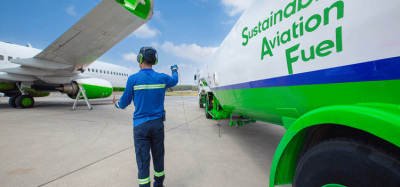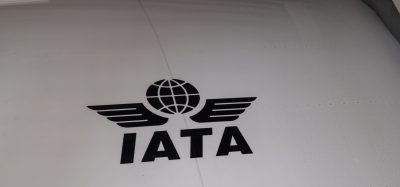An alternative way of thinking
- Like
- Digg
- Del
- Tumblr
- VKontakte
- Buffer
- Love This
- Odnoklassniki
- Meneame
- Blogger
- Amazon
- Yahoo Mail
- Gmail
- AOL
- Newsvine
- HackerNews
- Evernote
- MySpace
- Mail.ru
- Viadeo
- Line
- Comments
- Yummly
- SMS
- Viber
- Telegram
- Subscribe
- Skype
- Facebook Messenger
- Kakao
- LiveJournal
- Yammer
- Edgar
- Fintel
- Mix
- Instapaper
- Copy Link
Posted: 11 April 2011 | Mark Rumizen, Aviation Fuels Specialist in the Aircraft Certification Division, Federal Aviation Authority (FAA) | No comments yet
In the early afternoon of 7 January, 2009, a Continental Airlines Boeing 737 airliner lifted off the tarmac of Houston’s George Bush Intercontinental Airport with a blend of biofuel and conventional petroleum-derived fuel feeding one of its two CFM International jet engines…
In the early afternoon of 7 January, 2009, a Continental Airlines Boeing 737 airliner lifted off the tarmac of Houston’s George Bush Intercontinental Airport with a blend of biofuel and conventional petroleum-derived fuel feeding one of its two CFM International jet engines.
This event, along with three similar demon stration flights by Air New Zealand, Japan Airlines, and KLM marked a major step forward in addressing one of commercial aviation’s most pressing concerns. The airlines need sustainable alternative fuels to address a myriad of environmental and economic challenges, and these flights demonstrated that they could soon have what they want.
Recent concerns with the impact of carbon emissions on global climate have generated a significant amount of regulatory focus on industries that produce these emissions.
Commercial aviation, like other industries such as electrical power generation, faces scrutiny of its carbon footprint from governments and Non-Governmental Organisations (NGOs). Sustainable alternative fuels that are derived from biomass may offset a portion of the carbon produced by the aircraft and help the industry meet its ultimate goal of carbon neutrality (see Figure 1 on pge 31). Air quality issues such as emissions of sulphur and particulate matter also may be mitigated by the use of alternative fuels. Commercial aviation is also concerned with the security and stability of the supply of crude oil from foreign countries (see Figure 2). Supply restrictions due to political unrest, trade barriers, or strategic objectives can have significant impact on the availability and price of jet fuel. The volatility in petroleum prices in recent years has caused fuel to become the single largest component of many airlines’ operating costs for the first time in history (see Figure 3 on page 33). High fuel prices have contributed to the challenges facing the industry. Fuels produced from coal, natural gas or biomass provide an alternative to petroleum and therefore can contribute to price stability and supply security.
CAAFI – The Commercial Aviation Alternative Fuels Initiative
Similar to commercial aviation, military air forces share the same concerns. In early 2006, the U.S. Air Force (USAF) initiated their efforts to procure semi-synthetic jet fuel made by the Fischer- Tropsch (FT) process. The USAF was initially concerned about the future availability of jet fuel derived from petroleum and embarked on an initiative to develop and deploy jet fuel made from alternative sources such as coal or natural gas. However, more recently, the environmental drivers mentioned above now take precedence with the passage of section 526 of the Energy Independence and Security Act of 2007. Under this new law, all US government entities, including the military, may only purchase alternative fuels with lower carbon footprints than conventional, petroleum-derived fuels.
These concerns and developments prompted commercial aviation stakeholders to establish the Commercial Aviation Alternative Fuel Initiative (CAAFI) in May 2006. CAAFI is a coalition of airlines, aircraft and engine manufacturers, energy producers, researchers, international participants and government agencies. Together these stakeholders are leading the development and deployment of sustainable alternative jet fuels for commercial aviation.
CAAFI’s goal is to promote the development of sustainable alternative jet fuel options that offer equivalent levels of safety and compare favourably on cost with petroleum-based jet fuel, while also offering environmental improvement and security of energy supply for aviation. The four organisations that take a leadership role in CAAFI as sponsors are the Aerospace Industries Association (AIA), the Air Transport Association (ATA), the Airport Council International – North America (ACI-NA), and the Federal Aviation Administration (FAA). CAAFI plays a key leadership role in the expediting and facilitating of key tasks relating to the evaluation, qualification, and deployment of sustainable alternative fuels. But CAAFI also serves as a means of exchanging information and coordinating stakeholder efforts. This is done through the holding of technical workshops, outreach to domestic and international aviation, energy, and financial industry forums, the development of evaluative tools for assessing alternative fuel development status, and communication with the news media.
Certification and qualification of alternative aviation fuels
CAAFI and the aviation industry recently developed and issued the first fuel specification dedicated specifically to synthetic aviation fuel. This specification, ASTM International D7566-09, Specification for Aviation Turbine Fuels Containing Synthesized Hydrocarbons, was issued in September 2009. It provides criteria for the production, distribution and use of semisynthetic aviation fuel and this initial version includes aviation fuels made with Fischer- Tropsch (FT) fuel blending components. It is expected to pave the way for the use of aviation biofuels produced from more sustainable feedstocks, such as algae, camelina and jatropha. ASTM International is currently in the process of adding specifications for these types of biofuels to the next version of the standard.
The new fuel specification is intended for ‘drop-in’ fuels, which have essentially identical performance and compositional properties as conventional jet fuel. Drop-in fuels listed in D7566 are permitted to be seamlessly integrated into the infrastructure and on to the aircraft without the need for separate tracking or regulatory approval. Civil Aviation Authorities (CAAs) rely on industry and military fuel specifications to define which fuels are approved for specific aircraft and engines. So, the issuance of D7566 enabled both industry and CAA approval of FT fuels. Once a fuel completes the ASTM International qualification process it can be balloted to the ASTM International committee for incorporation into D 7566. If the ballot passes, then the fuel is ready to fly on all aircraft certificated to operate with conventional Jet A fuel.
CAAFI and the aviation industry also recently developed and issued new fuel qualification procedures in ASTM International D4054-09, Standard Practice for Qualification and Approval of New Aviation Turbine Fuels and Fuel Additives, also published in September 2010. This is being co-ordinated with the USAF Aviation Fuel Certification Office to align the commercial process with the military process for certifying alternative aviation fuels. These industry and military qualification processes are in turn being coordinated with the FAA and European Aviation Safety Agency (EASA) guidance for certification of alternative fuels.
Several future fuels are at various stages of qualification with the most prominent being Hydroprocessed Esters and Fatty Acids (HEFA). The following paragraphs provide an overview of the status of HEFA qualification effort and other current fuel qualification activity.
Hydroprocessed esters and fatty acids (HEFA) qualification
HEFA fuel is currently working its way through the ASTM International qualification process under the Emerging Fuels Task Force. It is produced from plant oils or animal fats that are hydroprocessed to remove oxygen and to make the oil lighter and more like jet fuel. The current ballot describes HEFA fuels as hydroprocessed synthesized paraffinic kerosene wholly derived from hydrogenation and deoxygenation of fatty acid esters and free fatty acids. HEFA fuel can be derived from biomass feedstocks such as camelina, jatropha, algae, tallow, halophytes or other plant or animal oils. HEFA will be initially approved only for blending with conventional jet fuel up to a maximum of 50% volume. It is expected that HEFA will be approved in mid to late 2011.
Synthesized kerosenes containing aromatics (SKA)
ASTM International recently formed a task force to evaluate Synthesized Kerosenes Containing Aromatics (SKA). Aromatics are ringed hydrocarbon molecules that contain double bonds such as benzene. The initial version of ASTM International D 7566 included an annex for FT synthesized kerosene that only permitted trace levels of aromatics, and the current draft version of the HEFA annex includes the same limitation. This is primarily due to the fact that these initial synthetic blending components could not be produced with aromatics, but aromatics are considered necessary in jet fuel at controlled levels for compatibility with elastomeric seals. However, some new products derived from downstream processing of FT synthetic crude oils can contain aromatics, but these new product streams cannot be used for aviation fuel under the current criteria specified in the FT annex. This task force was established to evaluate the properties of several candidate SKA fuels in preparation for eventual revision to D7566 to include these fuels as a blending component. In addition, it is anticipated that this effort may also support a longer term goal to approve fully-synthetic fuels that contain the necessary levels of aromatics.
Alcohol to jet
ASTM International has also initiated a task force effort to qualify synthetic fuels derived from alcohol. Several companies are involved in the development of processing techniques to produce a jet fuel blending component by dehydration and oligomerization of alcohols. Subsequent processing would include hydrogenating (or hydroprocessing) and fractionating. The alcohol intermediary product would be produced from sugars or lignocelluosic feedstocks using bio-chemical or thermo-chemical conversion processes. One process relies on syngas as the raw feedstock for production of the alcohol. Both biologic approaches such as fermentation, and catalytic approaches are being developed. Much work remains to qualify this fuel type, but testing and analysis of candidate fuels has already begun.
Other future fuel activity
Another challenge posed by producers of biofuels was related to the need to co-mingle petroleum and biomass feedstocks in refinery hydroprocessing equipment to optimise production efficiencies. This approach would not be compatible with the current D7566 framework which requires separate processing of synthesized aviation product streams until blending with conventional jet fuel.
Other technologies that are under con – sideration include synthetic biology, where genetically engineered micro-organisms are used to convert sugar to pure hydrocarbons, and pyrolysis, where cellulosic biomass is heated to break carbon bonds to allow formation of fuel like synthetic crude products for additional processing.
Environmental considerations
CAAFI and the aviation fuel industry are investigating the impacts of reduced sulphur and aromatic components of synthetic fuels. Initial data indicates that these fuels produce less particulate matter, which is the primary contributor to adverse health impacts of aviation emissions. These benefits will be of interest to airports and airlines that are located or operate in areas identified by environmental authorities as not meeting air quality standards.
Some alternative fuels may have higher hydrogen to carbon ratios, which would reduce carbon dioxide (CO2) emissions, and reduce climate impacts. Additionally, reducing particulate matter emissions, such as oxides of sulphur, may reduce aviation’s climate impact, although these mechanisms are not as well understood as those for CO2.
Alternative jet fuels that are produced and created from renewable sources may have reduced life cycle greenhouse gas emissions relative to jet fuel. Standards and processes for the well-to-wake, life cycle carbon footprint analyses of potential feedstock-fuel pathways that could be used to produce sustainable alternative jet fuels are being defined. These will address all greenhouse gas (GHG) emissions resulting from the creation of the alternative fuel – recovery, processing, and transport – as well as those resulting from its combustion. Sustainable aviation fuels present the opportunity for lower GHG emissions because biomass feedstocks absorb CO2 for growth during photosynthesis in relatively short time scales and can offset the CO2 produced during combustion.
Direct and indirect land-use changes are important aspects that must be evaluated when considering sustainable aviation fuels. Such changes include deforestation, conversion of grasslands to agricultural production, or diversion of agricultural production to fuel production. These may result in considerable GHG emissions, and potentially overwhelm the gains from CO2 absorption. However, with careful planning, these adverse effects can be avoided.
Other adverse environmental impacts from the production of alternative fuels that are currently being investigated include air, land, and water quality impacts due to increased coal mining for FT fuels, or large scale farming of biofuel feedstocks. FT fuels production may result in high levels of CO2 emissions that would require carbon capture and sequestration (a technology still under development for widespread application), and growing and harvesting of biofuel feedstocks could have unintended water, energy, deforestation, and food production impacts. Again, understanding these effects will enable maximising benefits while avoiding adverse impacts.
CAAFI and the aviation fuels community is working hard on the above issues to further advance the development, approval, and deployment of alternative aviation fuels. Interested parties are encouraged to participate and contribute to the activities described.
Issue
Related topics
Related airlines
Related organisations
Commercial Aviation Alternative Fuels Initiative (CAAFI), Federal Aviation Administration (FAA)

















